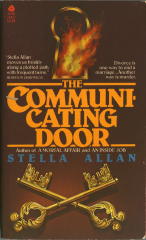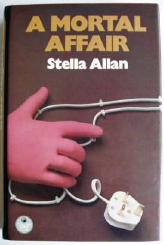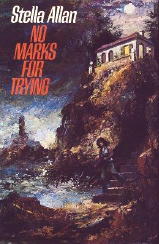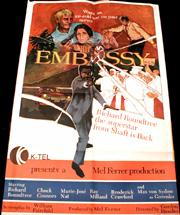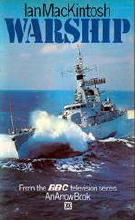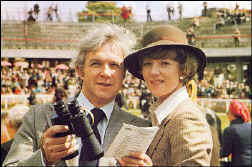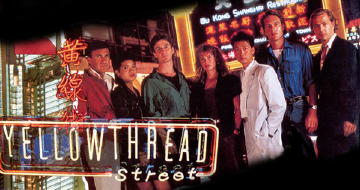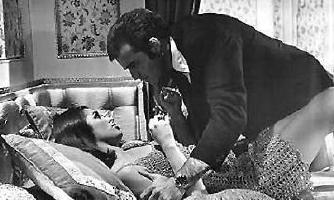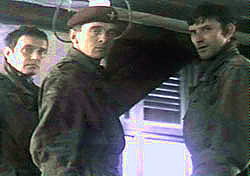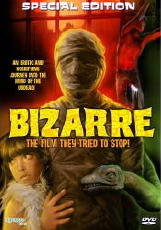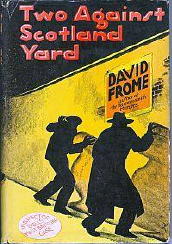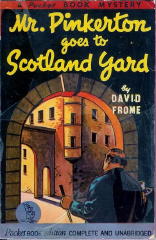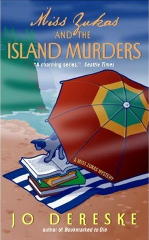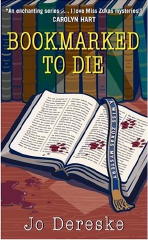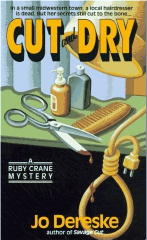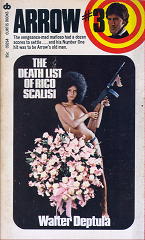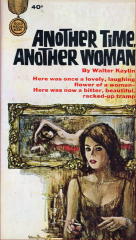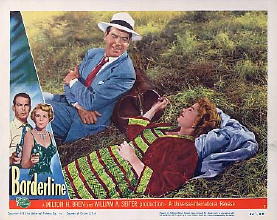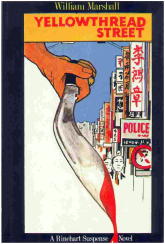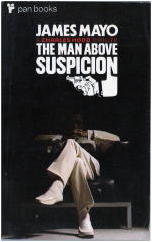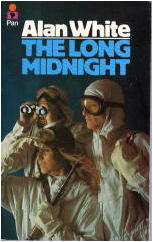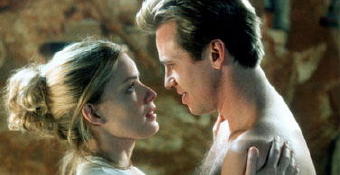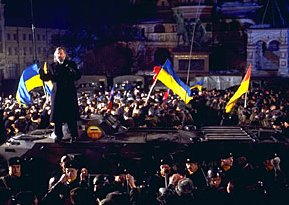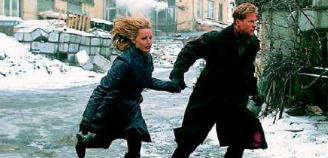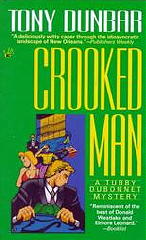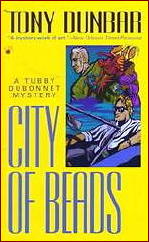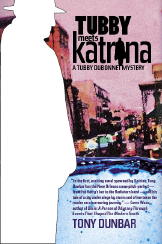May 2008
Monthly Archive
Wed 14 May 2008
A visit to the Book Barn in Niantic, one of Connecticut’s few surviving bookshops, netted me well over 100 mysteries yesterday, including a few recent hardcovers in nice shape. Of the paperbacks, so far I’ve found two (indicated with an *) from which I’ve gleaned information that Al Hubin did not have in the Revised Crime Fiction IV. He does now. These entries will appear in Part 28 of the online Addenda.
Need I add that any additional information is always welcome? It is, and I just did.
ALLAN, STELLA. British author of six mystery novels included in the Revised Crime Fiction IV. Many of her books seem to focus on unhappy marriages and/or bad love affairs. See below.
Arrow in the Dark. Collins, UK, hc, 1982.
* The Communicating Door. Love Stories, UK, 1986. Avon, US, pb, 1981. Add setting: London. “Divorce is one way to end a marriage… Another way is murder.”
A Dead Giveaway. Collins, UK, hc, 1980. St. Martin’s, US, hc, 1981. Setting: England; theatre. [A successful playwright visits the country retreat of her wealthy ex-lover on the behalf of her new lover and finds herself embroiled in kidnaping, and murder.]
An Inside Job. Collins, UK, hc, 1978. Scribner, US, hc, 1978. Setting: London. Scribner, 1978. “It was a plan so perfect they could get away with murder..He would do anything to get rich, and she would do anything to keep him.”
A Mortal Affair. Collins, UK, hc, 1979. Scribner, US, hc, 1979. [The lover of a woman married to a doctor is exposed as a criminal.]
No Marks for Trying. Macdonald & Janes, UK, hc, 1975. Avon, US, pb, 1981. Setting: Spain. [A married couple’s vacation in Spain turns into a nightmare of murder and intrigue when they meet a man with whom the wife once had an affair.]
KRAUSE, KATHALYN. Author of several works of romantic fiction, two of them included in the Revised Crime Fiction IV. See below.
* The Blue Key. Belmont, pb, 1980. Add setting: Los Angeles CA. “A piece of stone jade unlocked the door to violence and death.”
Mellona. Belmont, pb, 1979. Make setting more specific: California, 1901. [A young woman, new to a close-knit coastal resort community, resembles a woman who disappeared 30 before.]
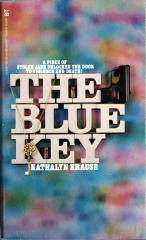
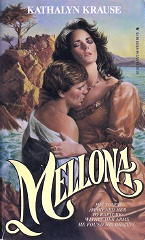
Mon 12 May 2008
Hi Steve,
Regarding your recent posting, in the interests of perhaps useless footnotes and trivia, I’d like to add some further film and TV notes to the following names:
Stephen COULTER
Film: Embassy (UK, 1972) d. Gordon Hessler. Screenplay by William Fairchild, based on the novel by Stephen Coulter. Story revolves around the efforts of a U.S. diplomatic mission in Beirut to smuggle out Max Von Sydow’s Russian defector. For followers of the absurd, this Mel Ferrer production cast Chuck Connors as a KGB assassin impersonating an American Air Force colonel.
Ian MACKINTOSH
TV: Warship (BBC, 1973-77) co-creator with Anthony Coburn of this 45 eps x 50 mins. drama about Royal Navy life onboard a frigate.
TV: Wilde Alliance (ITV, 1978) producer and occasional scriptwriter of the 13 x hour comedy-thriller featuring the amateur sleuthing adventures of a thriller novelist and his busybody wife (the latter in the Pamela North, Jennifer Hart vein).
TV: The Sandbaggers (ITV, 1978; 1980) creator and main writer (until his death in 1979) of this tightly made and occasionally grim espionage saga.
TV: Thundercloud (ITV, 1979) creator/writer/executive producer of the 13 half-hour comedy series featuring a group of sailors operating on a shore-based station that the Admiralty thinks is a destroyer in the North Sea.
William MARSHALL
TV: Yellowthread Street (ITV, 1990) was a 13-episode series adapted from the novel by William Marshall focusing on British detectives in the Hong Kong force; a costly, on-location production attempting Miami Vice on the seemingly Triad-ridden streets of steamy Hong Kong. Marshall also scripted the episode “Spirit Runner.”
James MAYO
Film: Hammerhead (UK, 1968) d. David Miller. Screenplay by William Bast, Herbert Baker, based on the 1964 novel by James Mayo. Features Vince Edwards as U.S. secret agent Charles Hood. The Variety review in July 1968 suggested that it ‘might be dubbed a junior edition of Goldfinger without any of the sock elements of the James Bond film’.
Alfred MAZURE
Film: Secrets of Sex (UK, 1969) d. Antony Balch. Screenplay by Martin Locke, John Eliot, Maureen Owen, Elliott Stein, Antony Balch; ‘Lindy Leigh’ segment based on the story by Alfred Mazure. Exploitation sex film featuring a collection of titillating stories connected by the view that sex is less often fun than funny (with truckloads of 1969 nudity for the furtive front-row viewer).
Mazure’s story tells of Agent 28 Lindy Leigh’s assignment by the British Home Office to rob the safe at the Moravian Embassy; she succeeds in her mission to enter the safe, only to discover that it’s a harem housing female agents who have failed in the same mission. The topless Maria Frost plays the topless Lindy Leigh.
Alan WHITE
Film: The Long Day’s Dying (UK, 1968) d. Peter Collinson. Screenplay by Charles Wood, based on the 1965 novel (US: Death Finds the Day) by Alan White. Men trained in the art of killing, in this instance three British paratroopers somewhere in occupied Europe during the Second World War, as skilled practitioners in nothing more than a competitive game (war) is the core of this film, starring David Hemmings, Tom Bell and Tony Beckley. The director takes some 95 dreary minutes to make his point.
Now, if only Secrets of Sex was available on DVD (for research purposes, of course)…
Regards,
Tise
>>> Thank you very much, Tise, and do I have news for you. Secrets of Sex is available on DVD in this country, subtly disguised as the following:
Sun 11 May 2008
DAVID FROME – Homicide House. Popular Library; paperback reprint. No date stated, but circa 1969. First edition: Rinehart, 1950. British title: Murder on the Square. Robert Hale, 1951. US hardcover reprint: Detective Book Club (3-in-1 edition), July 1950. Previously serialized in The Saturday Evening Post in seven parts between September 24 and November 5, 1949.
Since the subtitle of the hardcover edition is “Mr. Pinkerton Returns,” I’ll begin by listing all of the Evan Pinkerton books. While David Frome was byline listed on all of the books, you might better know “him” as Leslie Ford, author of the Grace Latham and Colonel John Primrose mysteries. Taken from Crime Fiction IV, by Allen J. Hubin:
The Hammersmith Murders (n.) Doubleday 1930 [England]
Two Against Scotland Yard (n.) Farrar 1931 [England]
The Man from Scotland Yard (n.) Farrar 1932 [England]
The Eel Pie Murders (n.) Farrar 1933 [England]
Mr. Pinkerton Finds a Body (n.) Farrar 1934 [Oxford]
Mr. Pinkerton Goes to Scotland Yard (n.) Farrar 1934 [England]
Mr. Pinkerton Grows a Beard (n.) Farrar 1935 [England]
Mr. Pinkerton Has the Clue (n.) Farrar 1936 [England]
The Black Envelope (n.) Farrar 1937 [Brighton]
Mr. Pinkerton at the Old Angel (n.) Farrar 1939 [England]
Homicide House (n.) Rinehart 1950 [England]
As you see, there was a gap well over ten years long between this, the last book in the series and the preceding one. There were 10 or 11 Grace Latham books that appeared in the interim. It wasn’t as though the author, whose real name was Zenith Jones Brown, 1898-1983, wasn’t doing any writing in the meantime. As Leslie Ford, her last book appeared in 1962 (Trial by Ambush) a non-series book.
My review of Ford’s The Woman in Black appeared here on the M*F blog a while back, in case you’d like to go back and take a look.
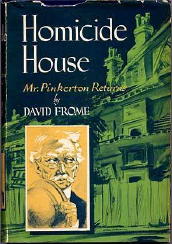
There are a couple of ways I could continue from here, and by flipping a mental coin, I’ll say something first about Mr. Pinkerton, whose adventures in murder mysteries I’ve now read the first I ever have. I’d assumed he was a stalwart sort of fellow, confidently solving crimes by the dozens as a friend and chief confidant of Chief Inspector Bull of Scotland Yard.
Wrong, all the way around. Evan Pinkerton is the meekest, most afraid-of-his-own shadow detective sleuth there has to be ever been. Now a widower and owner of an small apartment building in Godolphin Square, he is afraid to tell the landlady that he is indeed the owner, disbelieving as he does that he is himself. Perhaps his penny-pinching wife will come back from the grave and take it away from him, he fears. (This is being hen-pecked to the extreme, one thinks, and rightly so.)
And so he is stuck in a miserable room on the third floor, sharing a bath with the cook, who fortunately enough, is very seldom seen. The crimes he has solved, they must have been more or less by accident, as Bull has forcefully demanded that he quite positively stay away from any futures brushes with murder cases that need looking into.
Which leaves the current one at hand to tell you about. What struck me most, from the very first page, is that here is a mystery that is centered about a building that has been damaged by the bombing during the war. It’s now a few years after the war, and about all that is standing in the home across the square from Mr. Pinkerton’s are a few walls and the charred remains of a stone staircase. Nerves are often still shattered and decent food is still a problem.
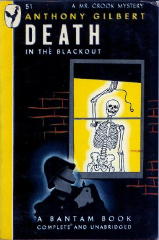
I may be wrong about this, but I am pointing this out because I do not believe that very many British mysteries written during or just after the war actually dwell on how difficult a time it really was for the general population. This is one of the few exceptions I can actually think of at the moment, the other being Anthony Gilbert’s Death in the Blackout (1942). I’m sure there are more, but if there were many, it would seem that the opening scenes of this book would not have struck me as being so unusual.
What I also found very striking is that how strong a Woolrich-ian sense of the sudden infatuation, coincidence and/or disorientation there is in the first few chapters. On page 7 Mr. Pinkerton meets Daniel McGrath hunting for the house that was damaged, seeking for the girl who had once lived there and whom he had met in a bomb shelter during the war, and here he is, six years later, having just come from America and planning to ask her to marry him, not even knowing her name.
Of course she now lives in the same building as Mr. Pinkerton, and of course she is not yet married, and of course she recognizes him immediately, but of course she slaps his face when she learns his name, his name being the same as a noted detective she assumes has come to find and arrest her father.
Whew. This makes for terrific reading, to be sure.
Here from page 43 is a passage that I hope illustrates exactly what I am saying. It describes their first meeting in six years, from McGrath’s point of view, as she is getting off a train:
She raised her head and pushed her dark hair from her forehead with a quick nervous gesture before she stooped to gather up her bags. For Dan McGrath standing outside on the damp murky platform it was as vivid an instant as he had ever lived. He was back in the Underground shelter on the dark, chilling stairs, the reek of fear and antiseptics in his nostrils, all hell loose in the invisible world above them, his arms tight around her, feeling her pounding heart against him, her breath in staccato tempo cool against his burning cheek. It was the instant he had lived six years to feel again. It was a sharp renascence, an affirmation of a dream that was no star-dusted illusion but brilliant reality, swelling his heart, melting it with sudden warmth and glowing tenderness. He had had a vision, and he had doubted it. There on the platform in the instant his doubts had been swept away.
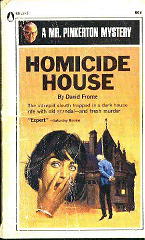
No mere mystery story could top a passage like this, and while Homicide House tries, it is doomed to failure. True love prevails — is it OK if I tell you that? — but with difficulty, some by purely natural causes, and some by authorial hand only — or if not the latter, then the wonderfully funny fickleness of fate.
Mary Winship’s father has disappeared, many years before — she now lives with her sickly mother and a truly formidable aunt in Mr. Pinkerton’s building — and vanishing at the same time was a valuable painting. And with Daniel McGrath unwittingly stirring things up, dead bodies begin to accumulate in Mr. Pinkerton’s abode.
The latter’s not much of a detective, or at least he’s not in this book, but his activities toward that end also initiate worry and concern on the part of a blackmailer and a killer, not (it is eventually discerned) one and the same. It all works out in the end, but the first seven chapters are what I’ll remember from this book, and not the last two (with a connecting bridge of largely filler material in between).
Fri 9 May 2008
JO DERESKE – Final Notice.
Avon, paperback original. First printing, November 1998.
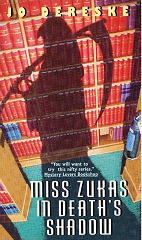
This is the sixth in Dereske’s “Miss Zukas” series, and as usual in my random, non-systematic way of doing things, the only one of them that I’ve read before this one is the one that follows this one.
And in fact, the incident that initiates that very same next one, Miss Zukas in Death’s Shadow, occurs on pages 18 and 19 of this one – she’s given a traffic ticket on the way to the airport to pick up her elderly aunt who’s coming in from Michigan for a visit.
Being a reference librarian either reinforces Helma’s sense of what is correct and proper, or it is what caused her to become a librarian in the first place. And being given a summons for turning right on a yellow light definitely does not fit her sense of what is correct and proper. Allow me to quote:
“I can’t sign this,” she told [the policeman].
“It’s not an admission of guilt, ma’am.” His voice grew louder, higher pitched. “You’re only acknowledging receipt of the ticket.”
“Then you’ll have to make it readable. You’ve spelled Wilhelmina incorrectly. I believe the time noted here is three minutes into the future. I can see your badge number is 087 but I’m unable to read your name: Olsen? Carolson? Camden? This document is too illegible for me to sign my name to. I’d like a rewritten ticket, please.”
Sure enough, at the beginning of the next book, the only one before this one that I’ve read, Miss Zukas is doing community service at a homeless shelter. I hope you don’t get the wrong idea, though. Miss Zukas is in her 30s, I believe, perhaps almost 40, but unfortunately I didn’t make a note of where I saw a reference to her age. If I have it wrong, I’ll change this small piece of data, and unless you remember, you’ll never know I had it wrong.
But the point is, she’s not a dottering old lady librarian, and while she’s not married, she does have a sort of boy friend in Bellehaven’s chief of police, Wayne Gallant. (Bellehaven is a fictional town, I believe, in Washington state.) This romance, if indeed that is what it is, is the strangest romance I’ve ever read about, as they are both rather reticent to speak about their relationship, even to each other.
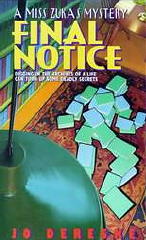
When Wayne Gallant’s ex-wife comes to town in Final Notice to reclaim her former husband, though, things between them (Helma and Wayne Gallant) begin to come to a boil. If a relationship can boil at less than room temperature, this one does. (He is always referred to Wayne Gallant, by the way, and when he calls Helma on the telephone, he says, “Helma, this is Wayne Gallant.” I found that … strange. In a nice sense, mind you.)
The dotty old lady in Final Notice is actually Helma’s Aunt Em, who back in Michigan (where she has lived her entire life, so far, or so Helma believes but soon discovers that it was not so) she had a “brain incident” and has become in behavior rather, shall we say, eccentric. And talkative. About her past. A past that Helma’s family had never talked about. Especially the time Aunt Em spent in Chicago during the rum-running days of Al Capone.
Dead in Helma’s apartment building parking lot is the same man who tried to steal Aunt Em’s purse at the airport. The identification is clinched by the three stab wounds in his arm produced by Aunt Em’s hat pin. Coincidence? Not very likely, but who? And why?
I enjoyed this, indeed I did. The detective work is minor, but it’s not dislodged, disrupted and disposed of completely. The characters are only mildly wacky and perhaps just as normal as any other group of people, including Miss Zukas’s fellow librarians, especially the director, a lady who believes that psychological color testing is a good way to maintain staff morale. Miss Zukas refuses. Naturally.
Here’s a list of all of Jo Dereske’s novel-length mystery fiction. Ruby Crane is a graphologist by profession, a forgery expert at a California detective agency. I’ve not read any of her adventures, but I’m sure that I read somewhere that she may be a cousin of Miss Zukas. If so, I imagine the cases she solves may be as much of a sneaky pleasure to read as this one.
Miss Zukas. All are Avon paperback originals.
1. Miss Zukas and the Library Murders (1994)
2. Miss Zukas and the Island Murders (1995)
3. Miss Zukas and the Stroke of Death (1995)
4. Miss Zukas and the Raven’s Dance (1996)
5. Out of Circulation (1997)
6. Final Notice (1998)
7. Miss Zukas in Death’s Shadow (1999)
8. Miss Zukas Shelves the Evidence (2001)
9. Bookmarked to Die (2006)
10. Catalogue of Death (2007)
11. Index to Murder (2008)
Ruby Crane. All are Dell paperback originals.
1. Savage Cut (1996)
2. Cut and Dry (1997)
3. Short Cut (1998)
Fri 9 May 2008
The entry for Tom Barling in the Revised Crime Fiction IV, by Allen J. Hubin, has been extensively revised, and corrections, deletions and other changes appear now as you see below in Part 19 of the online Addenda.
The other entries in this post come from Part 27, the paperbacks chosen largely because I had copies on hand to obtain cover images from. These are the ones you’ll also find below.
BARLING, TOM. 1936- . Add year of birth and full name: Thomas F. R. Barling. British author of eleven crime novels included in the Revised Crime Fiction IV. Series character: Charlie Dance, an ex-London gangster who in three books battles various crime syndicates and his own former mob. Tom Barling is also well-known as a comic illustrator and an animator on the 1973 TV series of The Addams Family. [Thanks to Steve Fearn for pointing out that the two Tom Barling’s are one and the same.]
_Dance with Death. Pocket, pb, 1988. US reprint of Smoke Dragon (Corgi, 1988). Correction: Previously stated to to be the US edition of God Is an Executioner.
_Dance with the Devil Pocket, pb, 1988. US edition of Smoke Dance (Corgi, 1991).
God Is an Executioner. Corgi, UK, pb, 1987. Correction: There is no US edition and SC: Charlie Dance does not appear. Delete the previously stated setting. [A ruthless gang of terrorists explodes into Matthew Pepper’s new life and kidnaps his wife and son, leaving no trace of them. ]
The Smoke. Corgi, UK, pb, 1986. Add US edition: Bantam, pb, 1986. (Delete conjecture that the US title was Dance with the Devil.) SC: Charlie Dance. Setting: London, 1960s.
Smoke Dance. Corgi, UK, pb, 1991. (Correct date.) Add SC: Charlie Dance. Setting: London, 1960s. (Add the time period.) US title: Dance with the Devil (Pocket, 1988). [Book 3 in the series: Charlie awakens the day after his birthday party to find that his wife has been killed and his illegally accumulated fortune has been stolen.] Note: Shown is the cover of the 1991 hardcover UK Severn House edition.

Smoke Dragon. Corgi, UK, pb, 1988. Add US title: Dance with Death (Pocket, 1988) and SC: Charlie Dance. Setting: London, 1960s. (Add the time period.)
DEPTULA, WALTER (J., JR.) ca.1934- . Series character: Frank Arrow, born Franco Arronelli, a professional thief who steals what others have stolen and returns it to its rightful owner for a fee. [This is a complete entry for the author. Numbers in brackets indicate the correct chronological sequencing.]
The Death List of Rico Scalisi. Curtis, pb, 1974. Add setting: New York City. [#3.] [Arrow’s estranged father is the target of a vengeance-mad mafioso.]
Naked Mistress. Curtis, pb, 1974. Setting: Hawaii, Mexico. [#2.]
Wine, Women … and Death. Curtis, pb, 1974. Setting: Hawaii. [#1.] “He had hot jewels and broads on his hands and every cold killer in Hawaii on his tail.”
FREEMAN, MARY E(LEANOR) WILKINS. 1852-1930. See author’s entry under Wilkins-Freeman, Mary E(leanor).
KAYLIN, WALTER. 1921- . At one time a resident of Old Lyme, CT. Occasional short story writer in the 1950s; author of one crime novel included in the Revised Crime Fiction IV. See below.
Another Time, Another Woman. Gold Medal, pb, 1963. Muller, UK, pb, 1964. Add setting: California. “… I had covered up manslaughter then. Now I had to cover up a murder.”
WILKINS-FREEMAN, MARY E(LEANOR). 1852-1930. Add as a new author entry. Ref: CA. Born in Randolph, Massachusetts; married Dr. Charles M. Freeman in 1902. (Her name is sometimes given as Mary E. Wilkins Freeman.) Noted American writer, known best for her stories centering around New England life.
-“Doc.” Gordon. Authors and Newspapers Association, 1906. Published in the UK as Doctor Gordon (Unwin, 1907).
_Doctor Gordon. Unwin, UK, hc, 1907. See “Doc.” Gordon.
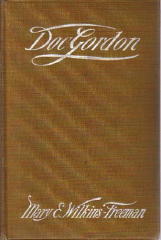
WILLIAMS, ALAN (EMLYN). 1935- . Son of actor-playwright (George) Emlyn Williams, 1905-1987, q.v. Brother of actor Brook Williams; briefly married to Maggie Noach, noted literary agent for children’s authors. Newspaper correspondent and author of eleven espionage-adventure novels included in the Revised Crime Fiction IV.
The Brotherhood. Blond, UK, hc, 1968. US title: The Purity League (Putnam, 1969). Also published in England under the US title (Panther, 1970). Add setting: Europe. [Journalist Magnus Owen and a beautiful undercover agent named Maya take on a sinister network called the ‘Brotherhood of Virtue.’]
_The Purity League. Putnam, US, hc, 1969. Panther, UK, pb, 1970. See: The Brotherhood (Blond, 1968).
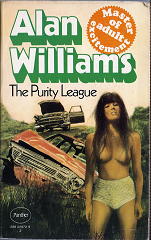
WILLIAMS, (GEORGE) EMLYN. 1905-1987. Father of author Alan (Emlyn) William, 1935- , q.v. , and actor Brook Williams, who appeared in numerous films and London stage productions. Noted Welsh actor and dramatist; author of two criminous novels cited in the Revised Crime Fiction IV, along with three crime-related plays.
Wed 7 May 2008
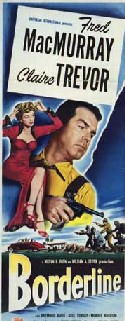
BORDERLINE. Universal Pictures, 1950. Claire Trevor, Fred MacMurray, Raymond Burr, Jose Torvay, Roy Roberts, Charles Lane. Directed by William A. Seiter.
I was sold a bill of goods by Oldies.com when I bought this DVD. The last line of the promotional copy on the back cover says, and I quote: “MacMurray’s icy cool performance and Trevor’s jittery energy create a chemistry that ignites this classic film noir.”
Film noir? It is to laugh, and believe it or not, even with another bravura performance by Raymond Burr as a thuggish dealer of dope in Mexico, you (the audience) were supposed to.
What a strange combination. Is this a noir film disguised as a comedy romance, or a comedy romance disguised as a noir film? My vote’s on the latter.
The only problem is – well, I’ll get back to that. Here’s the basic story line. Claire Trevor plays Madeleine Haley, aka Gladys LaRue, a Los Angeles policewoman in Mexico to see if she, as a woman under cover as a dancer and/or gang moll, can get some evidence on a slick crook named Pete Ritchie (that’s Raymond Burr, in fine form, as always). Fred MacMurray enters the film as Johnny Macklin, aka Johnny McEvoy, a henchman of an opposing gangster intent on taking over Ritchie’s trade.
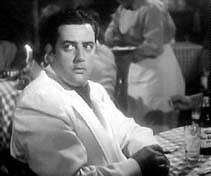
And the two of them, Trevor and MacMurray, take a trip up north together with a bird cage, complete with parrot, a music box, both filled in hidden compartments with packages of unspecified contraband. Both think the other is crooked, but somehow seeing beyond that, both begin to fall in love with each other. (Even so, Clare Trevor modestly sleeps with a gun in her hand in the room they stay in overnight together.)
Which is the way the movie goes, as well as the prevailing wind, until they reach the border, which is where the question becomes, does duty take over? I’ll not answer that, as I may have revealed too much already, but what I will say is that whatever type of movie this, it falls apart completely from this moment on. (And maybe I have a larger tolerance for misguided ventures like this than you do.)
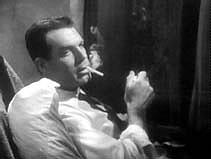
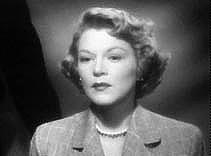
The problem is, for a romantic comedy, there are too many shootings and dead bodies to be completely funny, and for a film noir, there is simply too much silly nonsense going on. Pete Ritchie gives a good chase, but even that end of things fizzles out without so much as a bang.
Wed 7 May 2008
Most of these entries are from Part 27 of the online Addenda to the Revised Crime Fiction IV, by Allen J. Hubin. All but one of the books came from the lot I bought at the Windy City show, so the images of the covers you see were easy to come by.
The one exception referred to in the first line above is the newly expanded entry for Alfred Mazure, which is as it appears now in Part 26.
COULTER, STEPHEN. 1914- . Pseudonym: James Mayo, q.v. British journalist and author; served in World War II as one of American General Eisenhower’s staff officers. Under his own name, the author of eight espionage/adventure novels included in the Revised Crime Fiction IV, four of them published in the UK only.
LANCASTER, DONALD. Pseudonym of William (Leonard) Marshall, 1944- , q.v. The book below was commissioned to be written after the disappearance of the series creator, Ian Mackintosh, 1940-1979, q.v. The book is extremely scarce.
The Sandbaggers: Think of a Number. Corgi, UK, pb, 1980. Novel based on the characters in the TV series. Add SC: Neil Burnside (Roy Marsden) & Willie Caine (Ray Lonnen).
MACKINTOSH, IAN. 1940-1979. Correct both dates and spelling of last name (from MacKINTOSH). Born in Inverness; commissioned in the Royal Navy. Author of eight crime and thriller novels included in the Revised Crime Fiction IV; among these, three were novelizations of TV series the author created (Warship) or wrote and produced: Wilde Alliance, and the book below, about an elite British Intelligence covert operations unit. Mackintosh himself died in mysterious fashion. According to a Wikipedia entry, during the third season of The Sandbaggers in July 1979, he and a girlfriend were declared lost at sea after their single-engine aircraft strangely disappeared near Alaska after a radioed call for help.
The Sandbaggers. Corgi, UK, pb, 1978. Novelizes two episodes of the TV series: “Always Glad to Help” and “A Feasible Solution.” Add setting: London, Cyprus. Also add SC: Neil Burnside (Roy Marsden) & Willie Caine (Ray Lonnen). [Shown also in the cover image below is Diana Keen as Laura Dickens.] See the author’s entry for Donald Lancaster for a second book in the series.
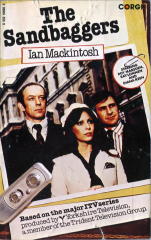
MARSHALL, WILLIAM (LEONARD). 1944- . Pseudonym: Donald Lancaster, q.v. Under his own name, the author of many mystery novels included in the Revised Crime Fiction IV. His best known series is the one that chronicles the adventures of the policemen who work out of the Hong Kong’s Yellowthread Station, beginning with Yellowthread Street (Hamish Hamilton, UK, 1975).
MAYO, JAMES. Pseudonym of Stephen Coulter, 1914- , q.v. Under this pen name, the author of eight spy/adventure novels included in the Revised Crime Fiction IV, six of them with sexed-up British super spy Charles Hood, billed as “the toughest of tough agents.” Four of the Hood books were also published in the US.
The Man Above Suspicion. Heinemann, UK, hc, 1969. SC: Charles Hood. Add setting: Windward Islands, France, Austria, London. [Shown is the cover of the 1970 Pan paperback edition.]
MAZURE, ALFRED (LEONARDUS). 1914-1974. Pseudonym: Maz, q.v. Under his own name, add the following titles. SC: Sherazad, a “sexy top agent of an ultra-secret organization,” in all titles.
Sherazad on a Trip. Mayflower, 1972
Sherazad Uptight. Mayflower, 1974
Welcome Sherazad. Tallis, UK, hc, 1969. Setting: London, England. “The Mystery of the Vanishing Film Starlets.” [Also shown is the cover of the Panther paperback reprint edition.]
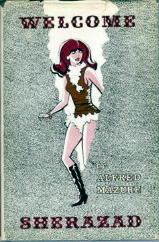
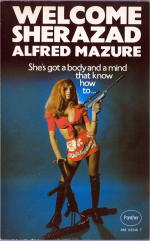
WHITE, ALAN. 1924- . Pseudonyms: James Fraser, Alec Haig, Bill Reade & Alec Whitney. Born in Yorkshire, England. Under his own name, the author of 18 spy and mystery novels included in the Revised Crime Fiction IV, three of them marginally. Series characters include Detective Inspector Armstrong; and Captain Colson of the British Special Services, a veteran of numerous commando raids during World War II.
The Long Midnight. Barrie, UK, hc, 1972. Harcourt, US, hc, 1974. Setting: Norway, World War II. Delete SC: Captain Colson. [Two men are sent to Norway, 1943, to uncover a traitor to the Nazi resistance. Shown is the cover of the 1973 Pan paperback edition.]
Tue 6 May 2008
THE SAINT. 1997. Val Kilmer, Elizabeth Shue, Rade Serbedzija, Valery Nikolaev, Alun Armstrong (as Inspector Teal), Roger Moore (voice only). Based on the character created by Leslie Charteris. Directed by Philip Noyce. [Novelization by Burl Barer; Pocket, 1997.]
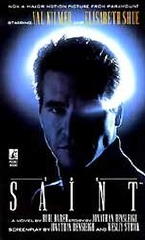
My first reaction? Beware of movies about fictional characters whose creators are not included in the on-screen credits. That’s what the common wisdom says, or if it doesn’t, it should.
Be also wary – this is my own advice – of movies that begin by telling the childhood origins of the character. Especially when said character’s exploits extended for well over a fifty year period (1928-1983) – under the control of said creator if not always written – without the creator ever finding the need to chronicle the characters origins, which are always (perhaps) best left to the reader’s imagination.
The reviews of this movie were almost universally bad, although in some cases as if reluctantly so, but – and this is a big but – the reaction of ordinary civilian reviewers (on IMDB, for example) have been almost universally positive. Some call it their favorite movie of all time, others while not going that far, admit to having watched it over and over again many times.
Why the great disconnect? I’ve thought it over for a couple of days now, and I’ve listened to the director’s voice-over commentary, which (as usual) pointed out any number of items I missed the first time through, and I think the division of opinion comes down to this.
Those who liked the movie did not know anything about Charteris’s character – a devil-may-care adventurer with an ever-present twinkle in his eye as he swindled the bad guys’ loot right from under their eyes – nor did they know anything of Roger Moore’s TV version of the character (much less George Sanders in the movie versions).
Roger Moore, I personally liked in the role, although (as I remember) he was a little stiff and not quite as rakishly (more impishly, perhaps) devil-may-care as I would have liked.
But Moore stopped playing the Saint in 1969, which (I’m guessing) is well before most of the viewing audience for this new version was born, and Val Kilmer is all they know (and all they got). Which may sound snarky, and if so, I mean only 30 to 40 percent of it.
For in fact, if you take the character he plays – he is not even Simon Templar yet, as this revisionist story would have it – without an idea of who he is to become – I think you might even enjoy watching this tormented loner, unsure of his true identity, a thief with undated Internet gimmicks and capabilities – not to mention his many disguises which are as varied and clever as they are numerous – and seeing him grow into someone whom the director refers to as “worthy of Sainthood.”
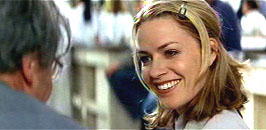
Thanks, of course, to the love of a beautiful woman, Dr. Emma Russell, played by Elizabeth Shue, an expert on cold fusion, the formulas for which some scummy post-Communist Russians would love to get their hands on.
That Emma Russell acts like she is sixteen years old and has never been within two feet of a man before is very nearly beside the point. She is innocent and vulnerable, and she is what Val Kilmer’s character needs to shake up his life and start him over again. (He certainly needs it.)
It also does not seem to matter that cold fusion does not seem to work, then or now, even though when a miracle is desperately needed in the movie – and in the middle of Red Square yet! – a miracle is certainly what indeed does happen.
Emma Russell’s heart condition also seems improve greatly as the movie goes on. Perhaps it is all the running she does, or edging her way with Simon along the icy flank of the Moscow River, or escaping with him through the city’s underground tunnels. Exercise like this is just what the doctor ordered. Or needed.
An earlier version in which she dies in the end was wisely, wisely reconsidered. The ending is a bit of a muddle anyway, but if her cheery optimism had been squashed in the end like a bug, the audience would have roundly booed. I would have, at least, and loudly.
My second reaction, then, ignoring the fact that movie is about a character I think I should know — but as the film goes on, I realize in frustration (if not something akin to anger) that I do not — with my expectations suitably altered, I enjoyed the movie considerably more the second time through than I did the first.
But will I ever watch it again? The future is hazy on that, but the possibility is higher than the chance that I will ever watch a version with George Sanders in it more than once. One with Roger Moore in it, from TV? Yes.
Tue 6 May 2008
Uploaded this morning, about 10 minutes ago, with no links or cover images added yet, is Part 27 of the ongoing online Addenda to the Revised Crime Fiction IV, by Allen J. Hubin.
I haven’t had a chance to look through this new set of addenda carefully myself, but I recognize quite a few of the pieces of information that I’ve sent Al in the last few weeks, including data he didn’t have about some of the British espionage paperbacks I bought at the Windy City show. Lots of newly discovered settings from other sources too, along with new authors, titles and series characters, not to mention newly discovered new editions with title changes, plus a few deletions and other corrections too.
I’ve fallen behind in the annotations which I do for the Addenda, adding images and links and so on, but as I get to them, I’ll be posting them here, as I always do. More later, in other words!
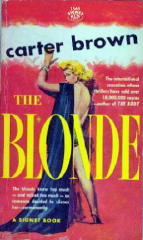
[UPDATE.] Later the same day. The comments that follow were produced by Al’s statement in this installment of the Addenda that:
BROWN, CARTER. Note: Some books published around 1960 may have been written by authors other than [Alan Geoffrey] Yates.
This doesn’t entirely agree with the rumors I’ve heard, which have suggested that it was the later ones that Yates may not have written. (His books began to appear in the US in 1957 or 1958, then continued until 1984 or so. Yates died in 1985.)
See the comments for more.
Sat 3 May 2008
TONY DUNBAR – The Crime Czar.
Dell, paperback original; first printing, November 1998.
My first reaction, when starting to read this fifth recorded New Orleans adventure of only slightly sleazy attorney Tubby Dubonnet, is that it takes place before hurricane Katrina came along. What a sorrowful scab on this country’s face that city is now. There’s a lot of atmosphere in this book, more or less a continuation of the preceding one, and I’ll get back to that aspect of it in a minute.
The background of eccentric native inhabitants and local cuisine is combined with a hand-brewed melange of hoodlums, crooked politicians and judges, and the laissez faire approach to life of Tubby himself to produce a potpourri of wackiness and Southern charm. (Well, I concede that crooked politicians are not charming, nor is the occasional violence that rips its way into the tale that Tony Dunbar has to tell in The Crime Czar, but there you are.)
The Tony Dunbar novels so far, as expanded upon from the listing in Crime Fiction IV, by Allen J. Hubin. All take place in New Orleans, Louisiana.
# Crooked Man. Putnam, hc, 1994. Berkley, pb, 1996
# City of Beads. Putnam, hc, 1995. Berkley, pb, 1996.
# Trick Question. Putnam, hc, 1996. Berkley, pb, 1997.
# Shelter from the Storm. Putnam, hc, 1997. Berkley, pb,1998.
# The Crime Czar. Dell, pb, 1998.
# Lucky Man. Dell, pb, 1999.
# Tubby Meets Katrina. NewSouth, hc, 2006.
And of course I have a couple of comments. The story in The Crime Czar seems to pick up right after Shelter from the Storm ends, leaving some open, unanswered questions as it does so. It is strange, then, to see the series switch not only from hardcover to paperback in the transition, but from one publisher to another as well.
The other obvious comment is that I did not know about this most recent book in the series until about five minutes ago, and I want to read it. Mr. Dunbar is obviously in love with the town where he lives – even with my having read only the one book in the series so far, I know this – and I need to know what he has felt and presumably still feels about the destruction (if not the rebuilding) of the city that was New Orleans.
I’ve ordered it online today.
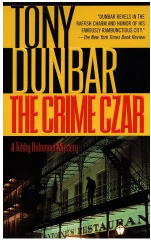
As for The Crime Czar, as mentioned up above, the story reads like a Chapter Two, and I’m sure it would have helped to have read Shelter from The Storm before it. The ongoing crime-tinged saga that is Tubby Dubonnet’s life does not seem to come in pre-packaged segments. It is, instead, continuous.
Tubby’s target in the book at hand: the man who seems to be behind all of the crooked wheelings and dealings in New Orleans, and for one instance in particular, the death of his friend Dan, left severely wounded in the earlier book.
Add to the tale a hooker named Daisy, boiling mad at the death of her new boy friend; a gang of Vietnamese gunmen, aiming to avenge the shooting of three of their countrymen; and Marguerite, upon whom Tubby is sweet, and another leftover from the previous book, having managed to flee with a fortune in jewelry. Don’t ask. I didn’t, and the story still went down swell.
It — the story — isn’t a major one, mind you. A minor caper, that is all. When one judge with his hand out goes down, another one pops up immediately. When one crooked cop is caught with his pants down, another one comes along with no delay. The fun is in the reading, though — a joyous, fun-loving affair for the most part, Big Easy style.
NOTE: No crawfish were harmed in the writing of this review.
« Previous Page — Next Page »
